14 Best Native Plants for Jacksonville, FL
BY LAUREN BRYANT | AUGUST 6TH, 2019 | FLORIDA, JACKSONVILLE, LAWN CAREThe subtropical climate of Jacksonville surely calls for a beautiful tropical garden. But wait — don’t purchase imported landscape plants just yet. North Florida has many gorgeous native plants, some only found in this state. You may even find native alternatives to plants you’re considering, such as hibiscus and azaleas.
Why native plants? Not only will they be easier to care for, but the local wildlife will thank you for it. These plants are much more likely to survive Jacksonville weather, pests, and diseases. If you’re ready to make your garden part of the local ecosystem, consider the following 14 native plants.
In this article, we’ll cover:
- Coral Bean
- Pink Pinxter Azalea
- Beautyberry
- Black-Eyed Susan
- Beach Sunflower
- Oakleaf Hydrangea
- Coontie
- Chickasaw Plum
- Southern Live Oak
- Sabal Palm
- Tickseed
- Hibiscus
- Coral Honeysuckle
- Carolina Jessamine
- How to Choose Native Plants for Your Jacksonville Landscape
- FAQ About Native Jacksonville Plants
- Where to Find Native Plants in Jacksonville
14 Native Plants for Your Jacksonville Yard
1. Coral Bean (Erythrina herbacea)
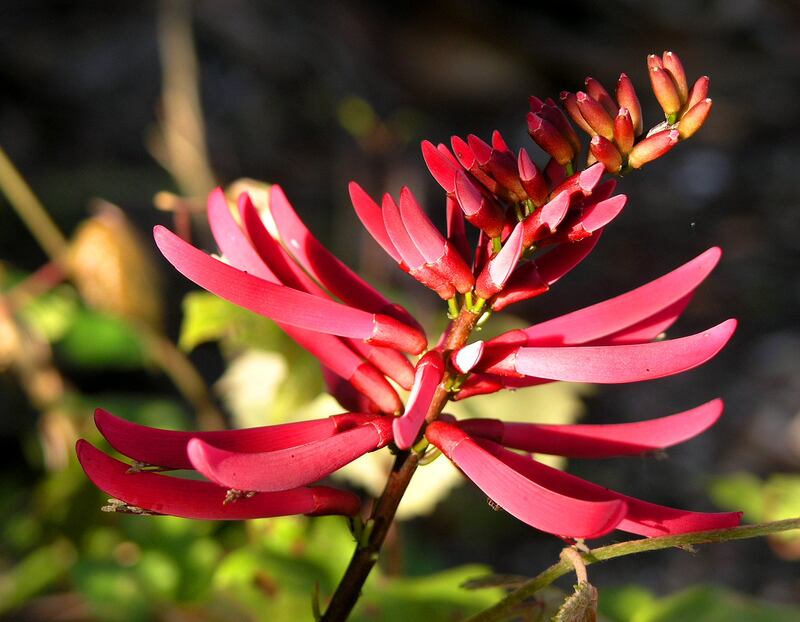
Photo Credit: Everglades National Park / Flickr / CC0 1.0
You get a two-for-one deal with coral beans: beautiful flowers and seed pods. The plant grows red tubular flowers in spring, attracting hummingbirds and butterflies. By fall, they’ll turn into pea pods with bright red seeds. They may look appetizing, but put away your fork and knife — they’re toxic if ingested.
Coral beans are visually appealing in spring and fall but don’t look exciting when not flowering or producing seeds. They’ll play an excellent supporting role in your garden landscape, so pair them with various plants for visual interest year-round.
Growth habit: Flower
USDA Hardiness Zone: 6a-9b
Mature size: Up to 6 feet
Duration: Perennial in Northern Florida
Foliage: Semi-deciduous
Sunlight needs: Full sun or light shade
Soil preferences: Fertile, sandy, and well-drained
Water needs: Low once established
Potential hazards: The seeds are poisonous – keep away from pets and children
2. Pink Pinxter Azalea (Rhododendron canescens)
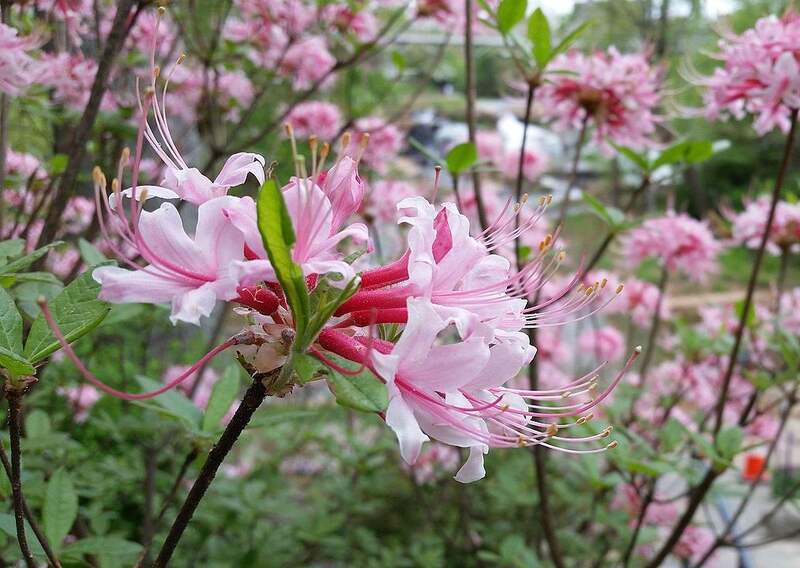
Photo Credit: EoRdE6 / Wikimedia Commons / CC BY-SA 4.0
Though many azaleas come from Asia or are hybrids, some are native to Florida. Pink pinxter azalea is native to the Jacksonville area, though other Florida varieties may also thrive here. This plant’s fragrant white to dark pink flowers are stunning in spring and attract hummingbirds and butterflies.
Pink pinxter azaleas have decent pest and disease resistance, but watch out for mites, iron deficiency, and mushroom rot. They do best when shielded from harsh winds. This plant is relatively slow-growing and needs little pruning. If you decide to prune, wait until after flowering. Do not allow people or animals to ingest this plant, as it could be deadly.
Growth habit: Shrub
USDA Hardiness Zone: 6b-10a
Mature size: 10-15 feet tall and 10-15 feet wide
Duration: Deciduous
Foliage: Perennial
Sunlight needs: Partial shade
Soil preferences: Well-drained
Water needs: Low
Potential hazards: Highly toxic if ingested; could be fatal
3. Beautyberry (Callicarpa Americana)
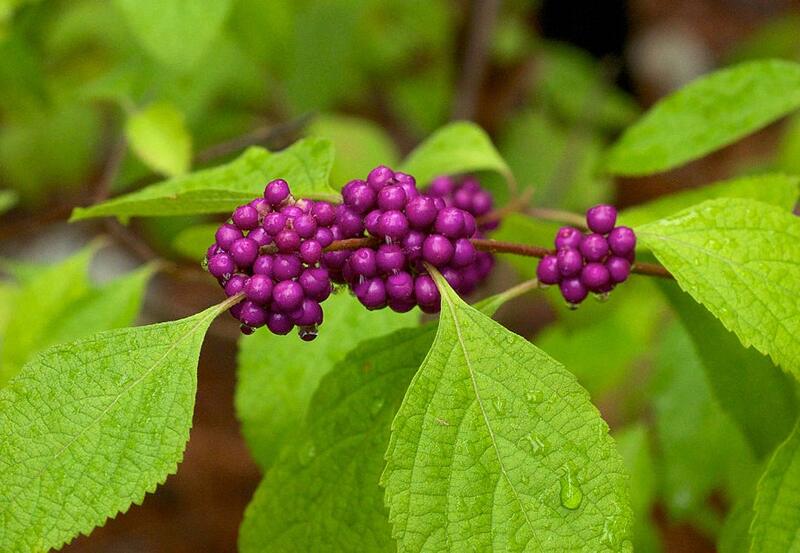
Photo Credit: Eric Hunt / Wikimedia Commons / CC BY-SA 3.0
As the name suggests, the American beautyberry’s fruit is the star of the show. Birds love eating them and have thus spread the seeds all over Florida. Humans can eat these berries in small amounts or make them into jellies and wines. The purple fruit appears around September, but you can enjoy its lavender-pink flowers in spring and summer.
This drought-tolerant plant works well for borders. If you decide to prune it, do so before it flowers for the best results.
Growth habit: Shrub
USDA Hardiness Zone: 7-11
Mature size: 3-8 feet tall and 4-8 feet wide
Duration: Perennial
Foliage: Deciduous
Sunlight needs: Full sun or partial shade
Soil preferences: Prefers rich soils but can also grow in poor, sandy soils
Water needs: Low
Potential hazards: Non-toxic for humans and animals
4. Black-Eyed Susan (Rudbeckia hirta)
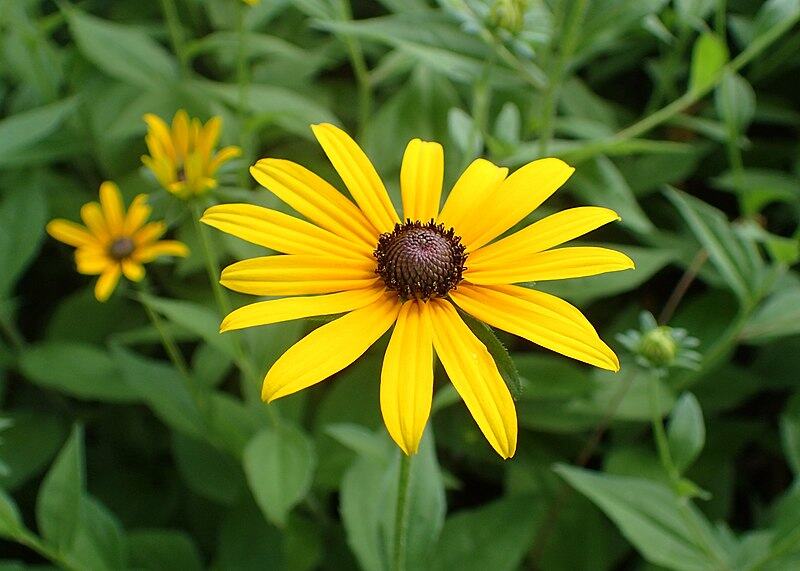
Photo Credit: Krzysztof Ziarnek, Kenraiz / Wikimedia Commons / CC BY-SA 4.0
Love wildflowers? The yellow, orange, and red colors of the Black-eyed Susan are a bright and cheery choice for gardeners in the Sunshine State. They flower in summer and fall. Use it for your butterfly garden, or pick some for a beautiful bouquet.
Black-eyed Susan is easy to grow and tough. It can handle drought and salt, making it ideal for coastal homes in Jacksonville. While they’re great for creating borders or carpets of flowers, they could become a weed since their seeds spread and germinate readily.
Growth habit: Flower
USDA Hardiness Zone: 2-11
Mature size: 1-3 feet
Duration: Deciduous
Foliage: Perennial
Sunlight needs: Full sun
Soil preferences: Can grow in most soil types
Water needs: Moderate
Potential hazards: Not poisonous to humans, but can be a skin irritant or cause allergic reactions if consumed; could be poisonous to grazing animals
5. Beach Sunflower (Helianthus debilis)
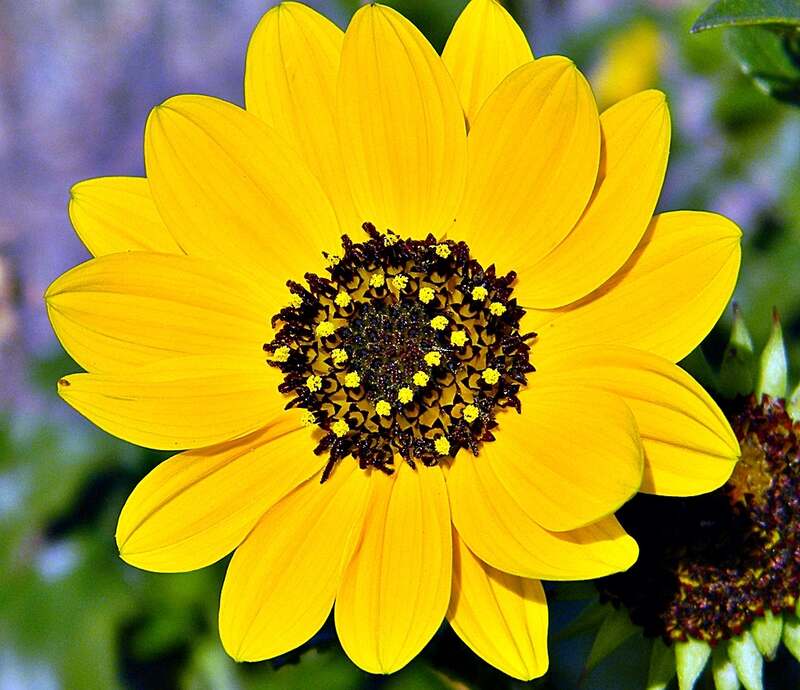
Photo Credit: Bob Peterson / Wikimedia Commons / CC BY-SA 2.0
The beach sunflower blooms practically year-round. Like other sunflowers, the flower head will turn to face the sun as it moves through the sky. Butterflies like its flowers, and birds like its fruit. Though there are several varieties throughout Florida, you should use the local variety, cucumber dune sunflower, to avoid hybridization with the native plant population.
Beach sunflowers are well-suited to hot, dry, salty coastal climates. Don’t overwater this drought-resistant plant, or it may fall victim to sunflower rust. Though beach sunflowers may not survive a freeze, they will reseed and quickly spread again, making an excellent ground cover. Fertilize once or twice a year at most.
Growth habit: Flower
USDA Hardiness Zone: 8b-10
Mature size: 2-4 feet
Duration: Perennial, but will be annual if there are freezing temperatures
Foliage: Semi-evergreen
Sunlight needs: Full sun
Soil preferences: Sandy or well-drained
Water needs: Low
Potential hazards: Non-toxic
6. Oakleaf Hydrangea (Hydrangea quercifolia)
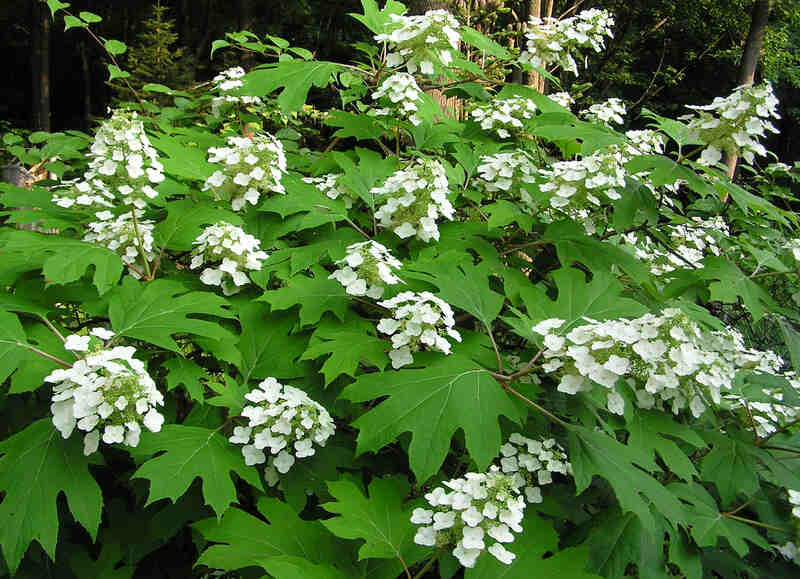
Photo Credit: normanack / Flickr / CC BY 2.0
The oakleaf hydrangea is aptly named for its leaf shape. The broad, dark leaves grow up to 12 inches long, with the biggest growing in the shade. The leaves may turn red, bronze, or purple in the fall and may stay on the plant into the winter. Cone-shaped flower clusters bloom in the summer months, then turn light pink or purple. In winter, the unusual peeling bark adds visual interest even when the plant is bare.
Because they prefer shade, oakleaf hydrangeas are perfect for yards with tree cover. They need little water or maintenance, but you should water them during dry spells and prune them periodically to your liking. Leave room for it to grow and send up new shoots, or get a dwarf or compact cultivar. Oakleaf hydrangeas aren’t kid or pet friendly since eating any part is toxic.
Growth habit: Shrub
USDA Hardiness Zone: 5-9a
Mature size: 6-10 feet
Duration: Perennial
Foliage: Deciduous
Sunlight needs: Prefers full shade, but partial is tolerable
Soil preferences: Does best in fertile, well-drained soil but can survive in other conditions
Water needs: Low
Potential hazards: All parts are toxic when ingested; keep away from children and pets
7. Coontie (Zamia intergrifolia)
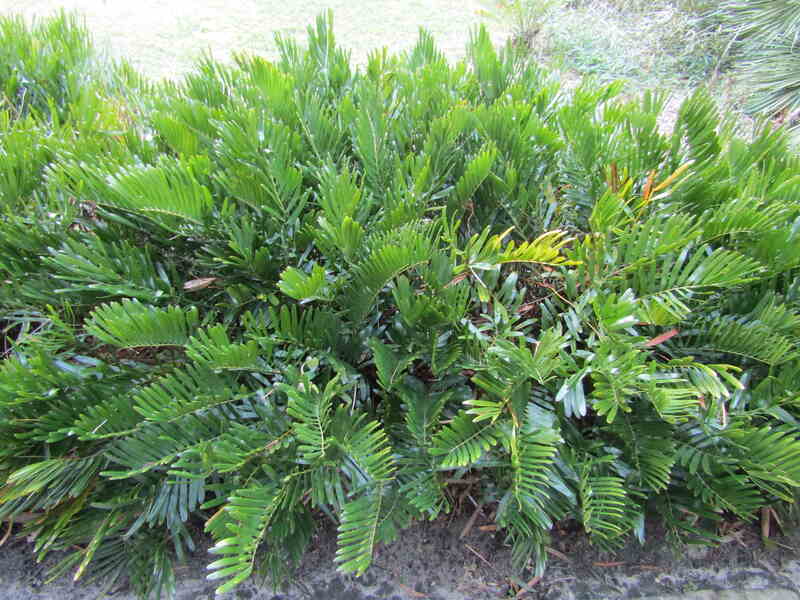
Photo Credit: Leonora (Ellie) Enking / Flickr / CC BY-SA 2.0
The coontie may look like a fern or palm tree, but it’s a cycad. Its glossy, feathery leaves are food for Atala butterfly larvae, a species once thought to be extinct in Florida. While the native people in this region historically created cooking flour from its stems, they are toxic unless properly prepared.
Coontie has a high drought tolerance and does well in the cold. Its mild salt tolerance helps it survive in coastal areas like Jacksonville. It does best in well-drained soil but will survive in full sun, partial shade, or full shade. Use coontie as a specimen plant or fill large areas with it for a wild look.
Growth habit: Cycad (shrub-sized)
USDA Hardiness Zone: 10a-9b
Mature size: 1-3 feet tall, 3-5 feet wide
Duration: Perennial
Foliage: Evergreen
Sunlight needs: Full sun, partial shade, and full shade
Soil preferences: Well-draining soil
Water needs: Low
Potential hazards: The stem is toxic to ingest unless properly prepared
8. Chickasaw Plum (Prunus angustifolia)
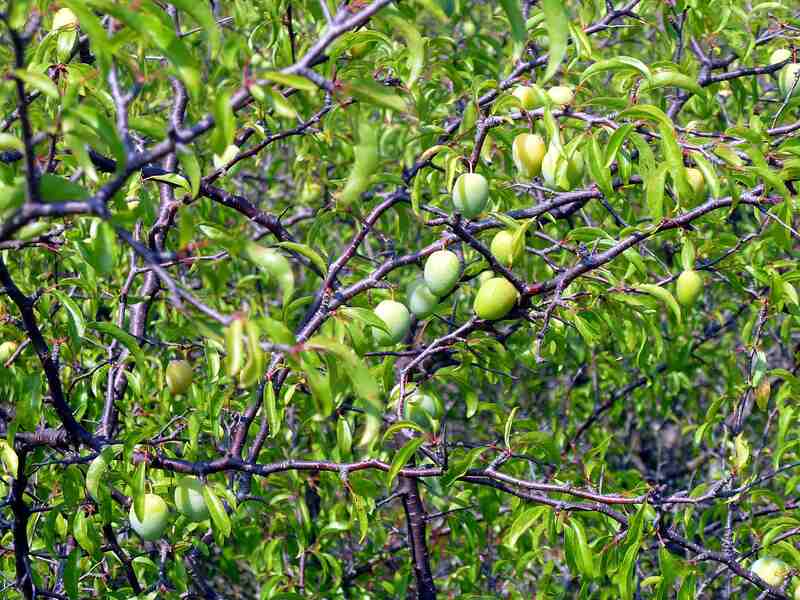
Photo Credit: Lm13700 / Wikimedia Commons / CC BY-SA 3.0
If you plant a chickasaw plum tree, its tiny white flowers will entice you with their smell. They look particularly striking since they bloom before the leaves have returned after winter. Soon the flowers will turn into red fruits that turn yellow as they ripen. You can eat them yourself or watch wild animals enjoy the feast.
Chickasaw plum trees grow quickly and resist most pests and diseases. Though they’re drought tolerant, they may need a drink during dry spells. One feature you may or may not like is the abundance of tree suckers, which are vertical stems growing near the base. They aren’t harmful to the tree and can benefit wildlife, but some people find them unappealing and messy. Prune them if you’d like.
Growth habit: Tree
USDA Hardiness Zone: 5-9
Mature size: Typically 6-12 feet, but can be up to 25 feet tall
Duration: Perennial
Foliage: Deciduous
Sunlight needs: Prefers full sun but can tolerate dappled shade
Soil preferences: Tolerates a wide variety of soil types but prefers acidic soils
Water needs: Low once established
Potential hazards: Low poison severity from cyanide in leaves, stems, and seeds when ingested
9. Southern Live Oak (Quercus virginiana)
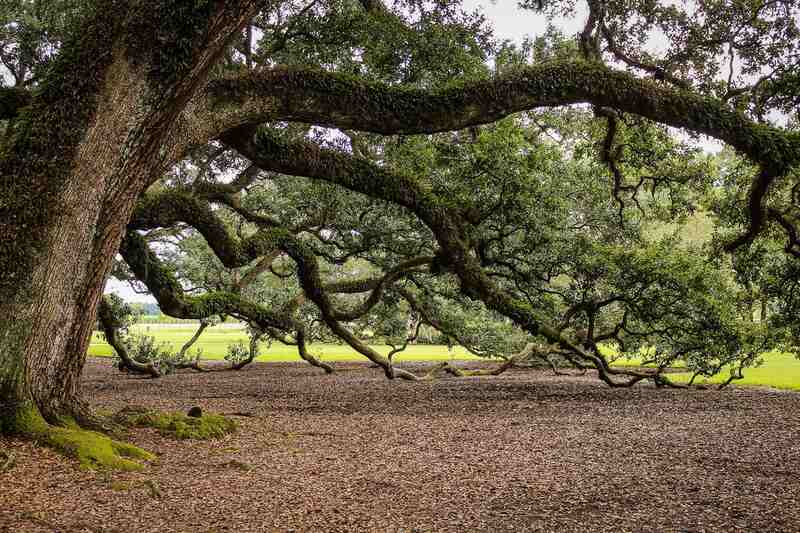
Photo Credit: Pxhere
Want a break from the harsh sun? Once established, a large southern live oak will provide plenty of shade in your yard. When fully grown, they can have a height of up to 60 feet and a spread of 100 feet. They can live for hundreds of years. You may see Spanish moss growing on it, but not to worry — it won’t hurt the tree.
Live oaks are best for large yards, so they have ample space to grow. Plan other landscaping accordingly; you don’t want your tree stealing all the sunlight from plants that need it. Pair with shade-tolerant plants to make sure all your green friends are happy. To improve wind resistance, prune your live oak regularly when young.
Growth habit: Tree
USDA Hardiness Zone: 7b-10b
Mature size: Up to 60 feet tall with a spread of 100 feet
Duration: Perennial
Foliage: Semi-evergreen or evergreen
Sunlight needs: Full sun
Soil preferences: Moist, well-drained soil
Water needs: Moderate
Potential hazards: Low toxicity to humans if young leaves or raw acorns are ingested
10. Sabal Palm (Sabal palmetto)
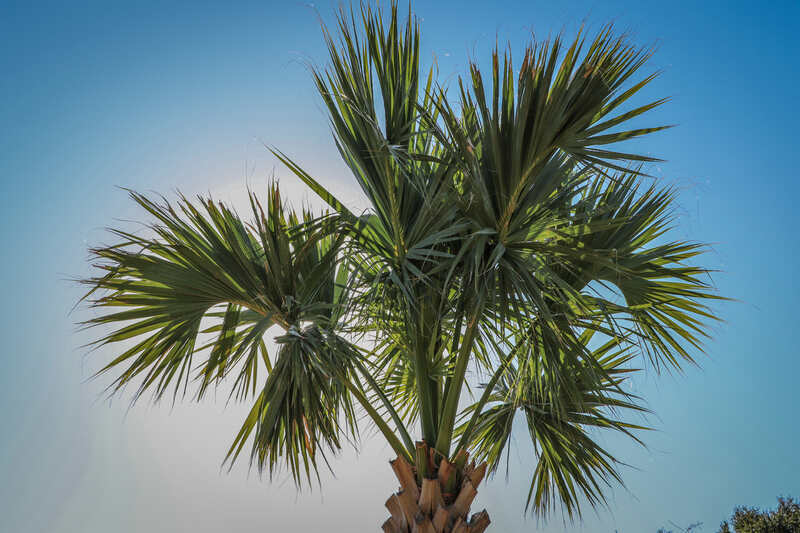
Photo Credit: Pxhere
Florida and palm trees go together like shrimp and grits. Want a local variety? Sabal palms earned the title of state tree in 1953. They’re also called cabbage palms or palmettos because the immature leaves taste like cabbage. The bud, or heart of palm, is also edible. Sabal palms produce tiny white flowers that pollinators love, then small black fruits that make a good snack for wild animals.
Despite the many edible parts of this plant, it’s not the best idea to handle the tree too much since the leaves may cause skin irritation. Sabal palms can handle salt spray but aren’t as tolerant of salt near their roots. Watch out for the fatal Lethal Bronzing Disease (LBD). While it’s incurable, preventative treatments could save your tree if others nearby are infected.
Growth habit: Palm
USDA Hardiness Zone: 7b-11b
Mature size: 40-50 feet
Duration: Perennial
Foliage: Evergreen
Sunlight needs: Full sun
Soil preferences: Sandy soil or well-drained loam
Water needs: Moderate
Potential hazards: Skin irritant
11. Tickseed (Coreopsis spp.)
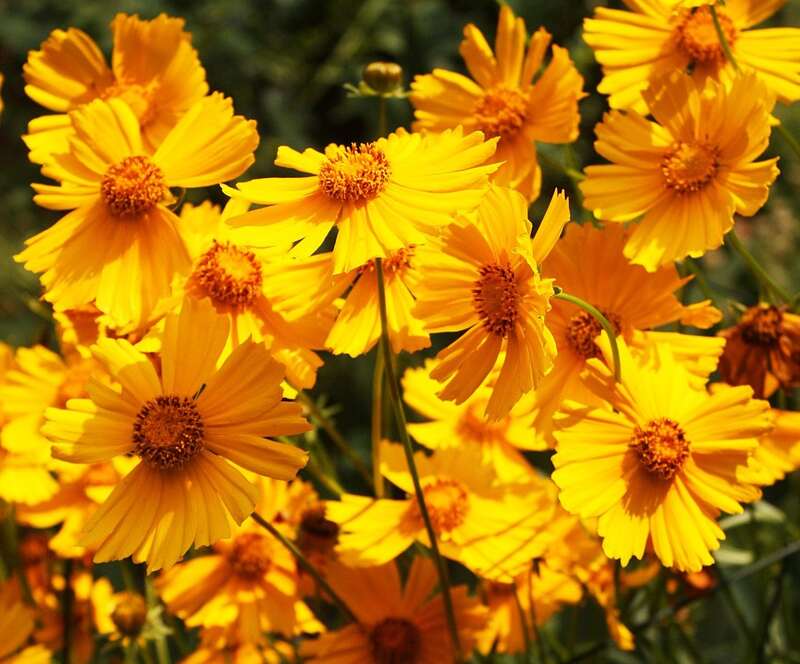
Photo Credit: Alabama Extension / Wikimedia Commons / CC0 1.0
The name may not sound pretty, but don’t judge a book by its cover (or title, in this case). These daisy-like flowers cover fields, gardens, and roadsides throughout Florida in spring, summer, and sometimes fall. Coreopsis, or tickseed, is Florida’s state wildflower and a type of aster. Though most have yellow petals, some varieties come in other colors, such as the purple Georgia tickseed.
There are several varieties of tickseeds in Florida. Coastal plain tickseed, Leavenworth’s tickseed, Texas tickseed, and Georgia tickseed are all found naturally in Duval County. Tickseed is typically drought tolerant, but it depends on the species. While short-lived, they can stick around for years since they reseed themselves. Taller flowers may need support to stay upright.
Growth habit: Flower
USDA Hardiness Zone: 4-10
Mature size: 1-3 feet
Duration: Annual to short-lived perennial
Foliage: Deciduous
Sunlight needs: Prefers full sun
Soil preferences: Prefers well-drained soils that aren’t overly rich; tolerates acidic, slightly alkaline, sandy, loam, and clay soils
Water needs: Moderate to low
Potential hazards: Non-toxic to humans and animals
12. Hibiscus (Hibiscus spp.)

Photo Credit: Quartl / Wikimedia Commons / CC BY-SA 3.0
While some hibiscus varieties originate in Asia, several are right at home in the Florida landscape. The varieties found naturally in Duval County are comfort root, scarlet rosemallow, swamp rosemallow, and crimson-eyed rosemallow. Though their colorful flowers are short-lived, hibiscus plants produce many flowers throughout the flowering season. Hummingbirds and butterflies will flock to them for nectar.
Hibiscuses come in shrub and tree forms suitable for hedges. These plants may be a good fit if your yard is too wet for other perennials since they prefer moist soil. Hibiscus are sensitive to the cold weather in North Florida, so they may lose their leaves and die away above ground. However, they can still return from the roots through shoots in spring. Watch out for aphids, whiteflies, and mealybugs.
Growth habit: Shrub or tree
USDA Hardiness Zone: 8-10
Mature size: 4 to 20 feet, depending on the variety; annual freezes will make the plant generally shorter
Duration: Perennials
Foliage: Deciduous
Sunlight needs: Full sun or partial shade
Soil preferences: Any soil that is not too dry; tolerates extended flooding and sandy, loamy, clay, and acidic soils
Water needs: Moderate
Potential hazards: Non-toxic; no safety hazards
13. Coral Honeysuckle (Lonicera sempervirens)
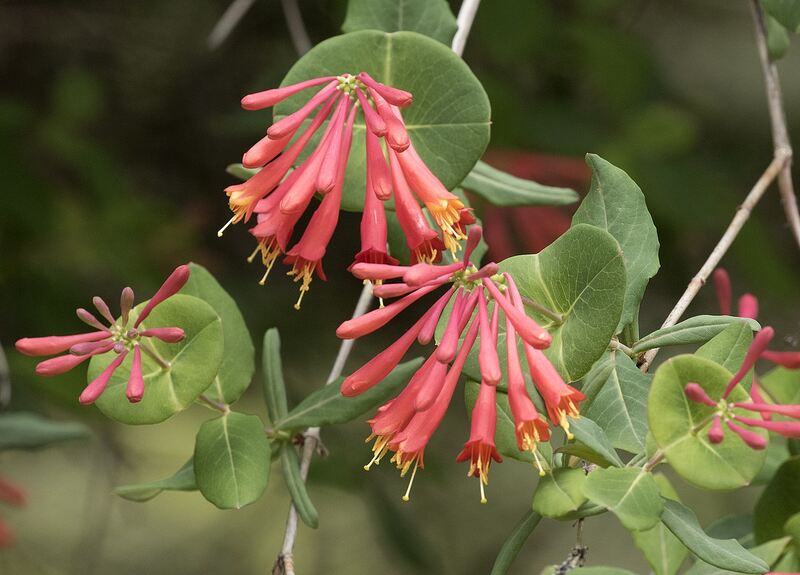
Photo Credit: Zeynel Cebeci / Wikimedia Commons / CC BY-SA 4.0
They may not live under the sea like real coral, but their clusters of long flowers are just as pretty. Coral honeysuckle is also called trumpet honeysuckle because of the flower’s shape. Most coral honeysuckle flowers are red, but some cultivars have pink or yellow flowers. Butterflies and hummingbirds will enjoy the flowers, and songbirds will enjoy the fruit that follows.
This vine is suitable for trellises, fences, hanging baskets, or erosion-preventing ground cover. Coral honeysuckle is low-maintenance, drought-resistant, and pest-resistant but won’t flower as nicely in the shade and may die back in freezing weather. Its fast growth can be aggressive, so carefully direct growth where you want. This local species is an excellent substitute for the invasive Japanese honeysuckle.
Growth habit: Vine
USDA Hardiness Zone: 4-10
Mature size: Up to 15 feet, but it depends on the supporting structure
Duration: Perennial
Foliage: Semi-evergreen
Sunlight needs: Prefers full sun but tolerates partial shade
Soil preferences: Does best in slightly acidic soils but tolerates most soil types; doesn’t do well in dry sands
Water needs: Low to moderate
Potential hazards: May upset stomach if consumed
14. Carolina Jessamine (Gelsemium sempervirens)
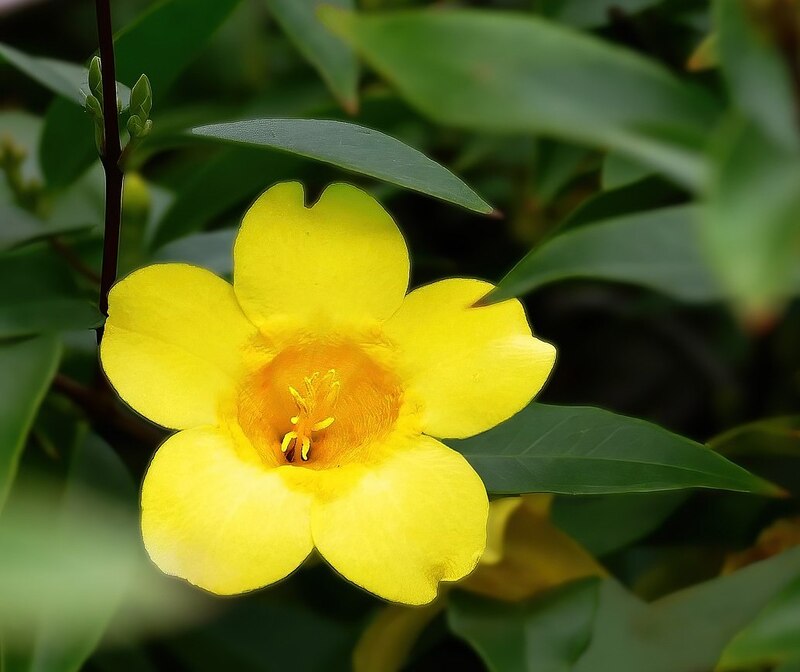
Photo Credit: Jim Evans / Wikimedia Commons / CC BY-SA 4.0
Want a taste of spring flowers before your other plants bloom? Carolina jessamine flowers in late winter and early spring. The flowers are yellow, fragrant, and trumpet-shaped (thus the nickname “evening trumpet flower”). The “Pride of Augusta” cultivar has double flowers and a longer blooming season. Look but don’t touch — the sap contains a skin irritant, and the whole plant is toxic, sometimes even to honeybees.
Carolina jessamine looks great on trellises, fences, and pergolas. It also works as a groundcover in sloped yards. The vine grows quickly but is containable. Carolina jessamine has few disease and insect problems and tolerates frost and drought. It may drop leaves if too dry, but it will bounce back quickly. Don’t overfertilize, as it reduces flowering.
Growth habit: Vine
USDA Hardiness Zone: 6a-10b
Mature size: Up to 20 feet
Duration: Perennial
Foliage: Evergreen
Sunlight needs: Prefers full sun but can tolerate partial shade
Soil preferences: Moist, rich, well-drained soil
Water needs: Moderate
Potential hazards: The whole plant contains poisonous toxins, including nectar that may be toxic to honeybees. It also has skin-irritating sap.
How to Choose Native Plants for Your Jacksonville Landscape
Jacksonville falls in the USDA Plant Hardiness Zone 9A, with this zone determined by the average minimum winter temperature. While non-native plants may still thrive in these conditions, native plants do even better. Native plants have adapted to everything in the area, from weather to soil salinity.
That said, each yard is slightly different. Get a soil test from your local cooperative extension or soil testing lab to learn about its texture (sand, silt, clay, or loam) and pH, nutrient, and salinity levels. You’ll also need to consider your current landscape. Are there shady trees? A nearby body of water? Ask your neighbors what plants have done well in their yards to understand what to expect.
You could choose plants specifically to attract wildlife, practical plants to provide shade on your patio, or the lowest-maintenance plants possible. Once you know what you want out of your yard, you can narrow down your choices.
FAQ About Native Jacksonville Plants
The bad news for North Florida residents is that many plants that bloom year-round in Central and South Florida won’t bloom in Jacksonville. You could get lantana, a native of South Florida, for your yard. However, be sure not to choose a non-native version as this species is invasive in the area and toxic to livestock. If you need your floral fix in winter, consider houseplants instead.
The best native plants to adorn your fence are coral honeysuckle and Carolina jessamine. If you’d prefer a non-climbing plant to hide your fence with, hydrangea and hibiscus will add the desired visual interest.
North Florida tends to have very sandy soils. This soil texture is good for plants that need good drainage but won’t work well for plants that prefer clay. The native plants on this list either prefer or tolerate the sandy soils typical in Jacksonville.
Where to Find Native Plants in Jacksonville
Sometimes, the best way to decide which plants to buy is to see them in person. The employees at your local native plant nursery can help guide you through the plant selection process. Here are some local garden centers that carry native plants:
Want to buy online? You can purchase plant seeds from the Florida Wildflowers Growers Cooperative.
While you’re at it, consider planting a new lawn or implementing low-maintenance landscaping. If you’re worried about storms tearing apart all your hard work, focus on hurricane-resistant landscaping to keep your garden and house safe.
You may find your new gardening journey overwhelming. Don’t be afraid to contact local landscaping pros in Jacksonville to handle anything you’re uncomfortable with or don’t have time for.
Main Image Credit: Canna lirio / PublicDomainPictures